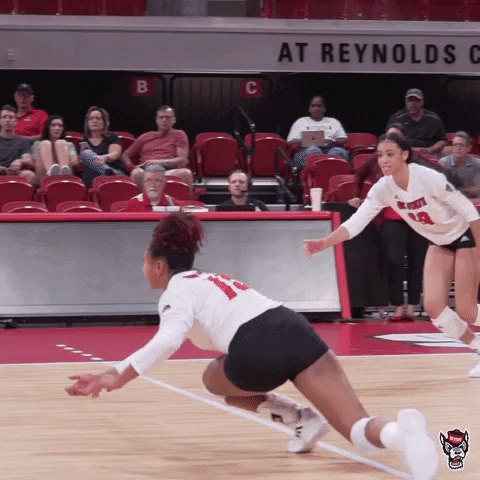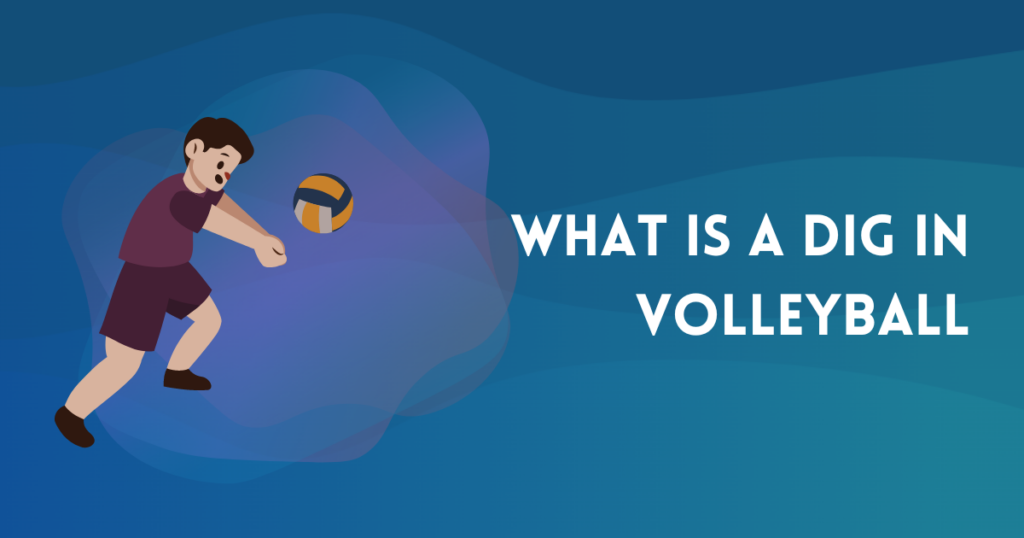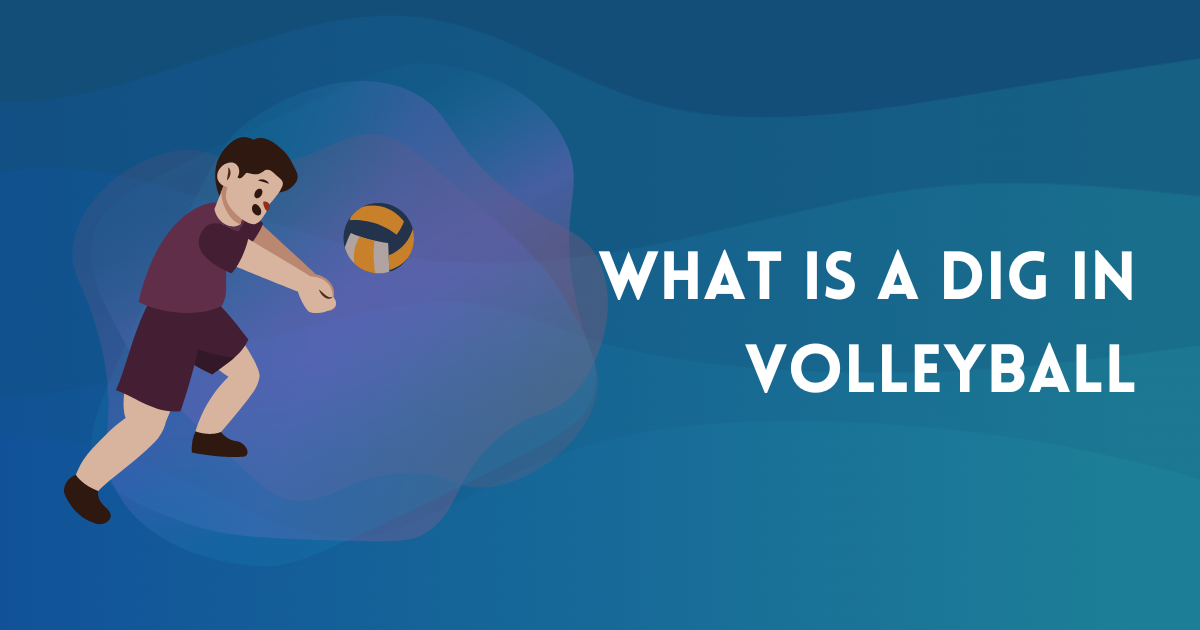Imagine yourself on a volleyball court, the tension building as the ball soars through the air. Your team’s fate hangs in the balance, with a powerful spike from the opposing side hurtling towards you.
What if I told you there’s a single move that can turn this potential disaster into a triumph?
Welcome to the world of the “dig” – a game-changing defensive skill that can mean the difference between victory and defeat in volleyball.
What Is a Dig in Volleyball?
A dig in volleyball is a defensive move that involves receiving and controlling a hard-driven ball from the opponent’s attack, allowing the team to transition into offense.

In this article, we’ll uncover the secrets behind the dig, exploring its significance, techniques, and how it can transform not only your game but also your team’s performance.
The Role of a Dig in Volleyball

Definition of a dig
In my experience, the dig is a crucial defensive skill that you should have in your repertoire. A dig is defined as a controlled pass of a hard-driven ball coming from the opponent’s attack, usually a spike or a serve.
The goal of a dig is to receive the ball and redirect it upward, allowing your teammates to set up a counterattack.
Situations in which a dig is used
Throughout my volleyball career, I have observed several situations where a dig is essential:
- Receiving a powerful serve: A well-executed dig enables you to control the ball and set up your offense.
- Defending against a spike: When the opposing team attacks with a spike, a successful dig can prevent them from scoring a point and create an opportunity for your team to counterattack.
- Covering tips or roll shots: Sometimes, opponents will use a softer touch or roll the ball over the blockers. In these cases, a quick dig can keep the ball in play and maintain your team’s offensive momentum.
How digs contribute to successful defense
As a player and coach, I’ve seen how a solid defense can make all the difference in tight matches. Digs are a key part of a successful defense, as they:
- Keep the ball in play: When you dig the ball successfully, you extend the rally and give your team a chance to score.
- Frustrate the opposing team’s offense: Consistently digging their attacks can demoralize the other team and force them to make errors.
- Create counterattack opportunities: A well-executed dig allows your team to transition from defense to offense, potentially catching the opposing team off-guard.
Now that we understand the role of the dig in volleyball, let’s explore the proper techniques to improve your digging skills.
Proper Dig Technique
Body position and footwork
As a professional trainer, I always emphasize the importance of proper body position and footwork when teaching the dig technique. Here are a few pointers to help you improve:
- Stay low and balanced: Keep your knees bent, and feet shoulder-width apart, and maintain a forward-leaning posture. This position allows you to react quickly and move in any direction.
- Be on your toes: Stay on the balls of your feet, ready to move swiftly towards the ball.
- Shuffle steps: Use quick, small steps to move laterally, keeping your body squared to the net. This footwork helps you maintain balance and control while moving to the ball.
Arm positioning and technique
Proper arm positioning is crucial for executing a successful dig. Here’s what you should focus on:
- Create a platform: Join your hands together, with one palm inside the other or interlocking your fingers, and extend your arms straight. Keep your elbows locked, creating a solid and stable platform for the ball to contact.
- Angle your platform: Adjust the angle of your arms to direct the ball upwards and toward your target, usually the setter. Remember to use your legs and shoulders to absorb the impact of the ball, avoiding swinging your arms.
Timing and reading the attack
As a player, I’ve learned that timing and anticipation are key to successful digs. Here are some tips:
- Observe the attacker: Pay attention to the attacker’s approach, arm swing, and body position to anticipate the trajectory of the ball.
- React quickly: Once you’ve read the attack, move swiftly to get in the path of the ball and prepare your platform for contact.
- Stay focused: Keep your eyes on the ball until the very last moment to ensure accurate contact and control.
Now that we’ve covered the proper dig technique, let’s discuss some drills to help you improve your digging skills.
Drills to Improve Your Digging Skills
Well, I strongly believe that practice is the key to improving your digging skills. Here are some drills that I recommend for players at different levels:
Individual digging drills
- Wall drills: Stand a few feet away from a wall and practice digging the ball against it, focusing on maintaining proper platform angle and body position. This drill helps you develop control and consistency in your digs.
- Self-toss and dig: Toss the ball up and slightly forward, then move quickly to get under the ball and dig it upward. This exercise helps improve your footwork, positioning, and reaction time.
Partner digging drills
- Rapid-fire digs: Have a partner stand across the net and hit or toss balls at you in quick succession. Focus on digging each ball accurately while maintaining proper technique. This drill helps you develop quick reflexes and better control under pressure.
- Cross-court digs: Stand diagonally across the court from your partner, who will hit or toss balls towards you. Practice digging the ball to your target, usually the setter’s position. This exercise helps improve your platform angle and ball control.
Team digging drills
- Dig or die: In this drill, the coach or a teammate sends balls over the net for players to dig. If a player successfully digs the ball, they remain in the game. If they miss or make an error, they are out. The last player standing wins. This high-intensity drill fosters competition and encourages players to focus on their digging skills.
- Rotational defense: Divide your team into two groups, with one group on each side of the court. The coach or a teammate initiates an attack, and the defenders must dig the ball and transition into their offense. After each successful dig, the defenders rotate positions. This drill helps players develop communication, coordination, and situational awareness on defense.
Now that we’ve covered some drills to improve your digging skills, let’s discuss some tips for successful digging on the court.
Tips for Successful Digging
As a volleyball coach, player, and professional trainer, I’ve learned that there are some key factors that contribute to successful digging. Here are a few tips to help you excel in this vital defensive skill:
Communication on the court
- Talk to your teammates: Keep the lines of communication open with your teammates, letting them know about potential threats and coordinating defensive coverage.
- Call the ball: If you’re going for a dig, call out “mine” or “got it” to avoid collisions and ensure that your teammates know you’re handling the ball.
- Listen to your teammates: Be receptive to the information your teammates share on the court, such as the location of the attackers or adjustments to your positioning.
Anticipation and quick reactions
- Study the opposition: As a player, take the time to observe the opposing team’s tendencies and patterns, which can help you anticipate their moves and improve your digging success.
- Trust your instincts: With experience, you’ll develop an intuitive sense of when and where the ball will be hit. Trust your instincts and react quickly to make successful digs.
- Stay agile: Keep your body loose and ready to move in any direction, ensuring that you can react swiftly to unexpected attacks.
Importance of mental toughness and resilience
- Embrace challenges: As a volleyball player, you’ll face tough opponents and difficult situations. Embrace these challenges as opportunities to learn and grow, both as an individual and as part of your team.
- Stay positive: Maintain a positive mindset, even when things aren’t going your way. A strong mental attitude can help you overcome obstacles and continue to push forward.
- Learn from your mistakes: Every player makes errors, but the key to success is learning from these mistakes and using them as stepping stones for improvement.
By applying these tips and continually working on your digging skills, you’ll become a stronger, more confident volleyball player. Now, let’s wrap up our discussion on the significance of the dig in volleyball and the importance of continuous improvement.
Conclusion
As a volleyball player, I can confidently say that the dig is an indispensable skill in the sport. Mastering the digging technique not only bolsters your individual defensive abilities but also greatly contributes to your team’s overall success on the court.
By consistently digging your opponents’ attacks, you can keep the ball in play, frustrate their offense, and create opportunities for counterattacks.
In volleyball, there is always room for growth, and the same holds true for your digging skills.
By dedicating time and effort to practicing proper techniques, participating in drills, and applying the tips shared in this article, you’ll steadily improve your digging abilities.
Remember that communication, anticipation, quick reactions, and mental toughness play a vital role in successful digging. Embrace challenges, learn from your mistakes, and always strive to become a better, more resilient player.
With persistence, dedication, and the right mindset, you can transform your digging skills and become an invaluable asset to your team, elevating your game to new heights.
